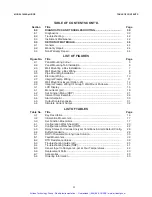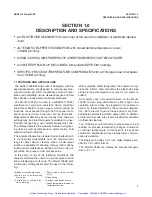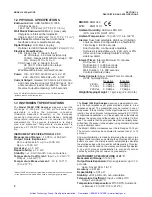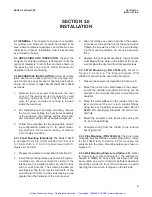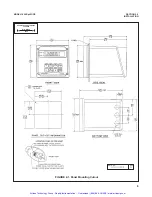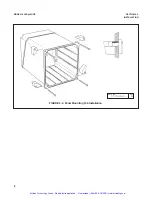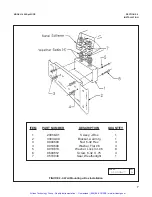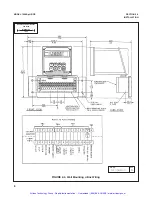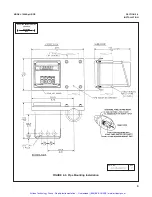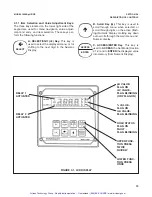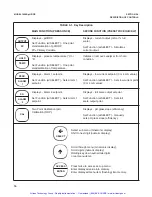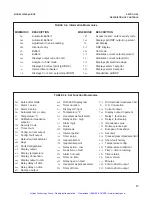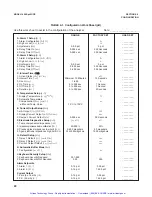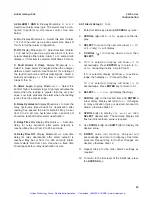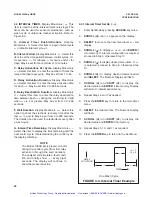
14
MODEL 1054B pH/ORP
SECTION 3.0
DESCRIPTION OF CONTROLS
SECTION 3.0
DESCRIPTION OF CONTROLS
3.1 KEYBOARD FUNCTIONS.
All functions of the 1054B are accessed through key-
board entry routines. The analyzer uses no switches or
potentiometers.
The four keys across the top row and the
CAL
(pH only)
and
ENTER
keys are dual function. One press of the
key will display the value of the function shown on the
lower portion of the key. A quick double press of the key
will display the value of the function shown on the upper
portion of the key. Each of these keys have read func-
tions that can be accessed without security code entry.
Each key also has a calibration or set function when
used with the
SELECT
key. This function requires entry
of the security code when the security feature is active.
(Refer to Section 6.0 for keyboard security.)
NOTE
When no key is pressed for a period of 60 sec-
onds the analyzer will default to reading pH.
CAUTION
The
HOLD
function and the
CAL
function
are not read functions. Refer to Section 5.3.
A. Standardize pH/ORP.
Standardi-
zation of the pH/ORP sensor is achieved
by pressing the
PV
key once, followed
immediately by pressing the
SELECT
key.
Std
displays to acknowledge the
standardize function, followed by the
Numeric Display for user input. Entering
the known pH/ORP of the measured
solution will cause the analyzer to
restandardize the sensor. The pH glass
slope value will not be changed. Refer to
Section 5.4.
B. Standardize Temperature.
Stand-
ardization of the temperature is achieved
by pressing the
TEMP
key once, followed
immediately by pressing the
SELECT
key.
AdJ
displays to acknowledge the
standardization function, followed by the
Numeric Display for user input. Entering
the known temperature of the measured
solution will cause the analyzer to
restandardize the temperature reading.
Refer to Section 5.2.
C. Alarm 1 and Alarm 2 Setpoint.
The
alarm setpoint may be adjusted by
pressing the
ALARM 1
or
ALARM 2
key
once, followed by pressing the
SELECT
key.
AdJ
displays, followed by the
Numeric Display for user input. Refer to
Section 4.10.
D. Current Output – Zero Setpoint.
The
zero point (0 or 4 mA) of the pH output
range is adjusted by pressing the
ZERO
key twice, followed by pressing the
SELECT
key.
AdJ
displays, followed by the
Numeric Display for user input. Refer to
Section 4.11.
E. Current Output – F.S. Setpoint.
The
full scale point (20 mA) of the pH output
range is adjusted by pressing the
F.S.
key
twice, followed by pressing the
SELECT
key.
AdJ
displays, followed by the
Numeric Display for user input. Refer to
Section 4.11.
F. Two Buffer Calibration (pH).
A two
buffer calibration is initiated by pressing
the
CAL
key once. Refer to Section 5.3.
Calibration (ORP)
. A calibration is
initiated by pressing the
CAL
key once.
Refer to Section 5.3.
G. pH Glass Slope.
The millivolt output
per pH unit is adjusted by pressing the
CAL
key twice, followed by pressing the
SELECT
key once.
AdJ
displays, followed
by the Numeric Display for user input.
Refer to Section 5.5.
H. Simulate Current Output.
The pH
output can be simulated by pressing
the
PV
key twice, followed by pressing
the
SELECT
key. The Numeric Display
appears for user input. Refer to
Section 4.12.
ZERO
ALARM 1
OUTPUT
PV
HOLD
TEMP
CAL
ZERO
ALARM 1
F.S.
ALARM 1
OUTPUT
PV
CAL
Artisan Technology Group - Quality Instrumentation ... Guaranteed | (888) 88-SOURCE | www.artisantg.com

